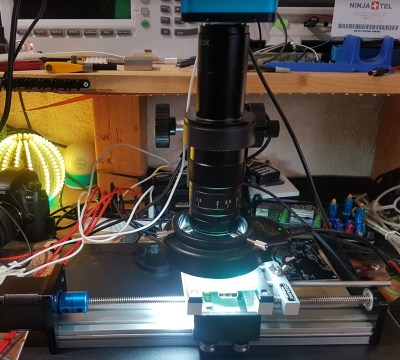When film all came in rolls, it was fairly easy to play with the frame of the image. Companies like Hasselblad (and many others) made camera backs that would expose longer strips of 35 mm film to create stunning panoramic images in one single shot. [snappiness] wanted to bring that style of camera into the digital age, and ended up with a 2-in-1 Sony-based frankencamera.
Sensors just aren’t readily available in the wide aspect ratio [snappiness] was looking for, and even if they were, bare sensors are hugely expensive compared to consumer cameras. Lacking the budget for high-res scientific CMOS, [snappiness] did what any of us would do, and hacked two Sony A7ii full-frame mirrorless cameras together to get a combined 24x72mm sensor frame.
Conceptually, the hack is really very simple: a 3D print acts like a T-fitting, with the two cameras held parallel off the arms of the T and the lens making the shaft. Inside, the only optics are a pair of mirrors serving as a beam splitter. Each camera sees half the FOV of the lens in its corresponding mirror, which means the images can be stitched together later to make the double-wide pictures [snappiness] is after.
Of course both cameras must be triggered at the same time, but with what looks like a headphone splitter and an aftermarket remote shutter button, that part works perfectly. The optics, not so much– as always with conceptually simple projects, the devil is in the details, and here it’s the mirror alignment where you’ll find Old Nick. [snappiness] made no provision for adjustments, so everything needed to be designed and built with very stringent tolerances. Somewhere along the way, those tolerances were exceeded; as a result, the two cameras don’t share a focal plane.
That means half the composite image will always be out of focus, or that the main lens needs to be refocused and two snaps taken, rather defeating the point the frankencamera. If [snappiness] attempts a version two, perhaps an adjustment mechanism to focus each sensor would be in order. Still, even if it didn’t work perfectly, he’s proven that the idea is sound, and we can’t imagine many people will see this and argue it isn’t a hack.
The world of film did make all of this easier, perhaps– we’ve seen large-format film cameras out of lego, and a panorama made from four full rolls of 35 mm film. If you know of any other great photography hacks– film or digital– don’t hesitate to send us a tip.
Continue reading “Double The Sensors, Double The Fun, With 2-in-1 Panoramic Camera”














